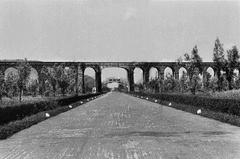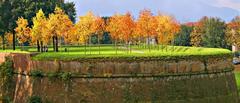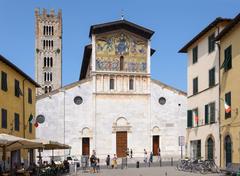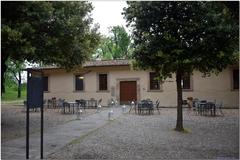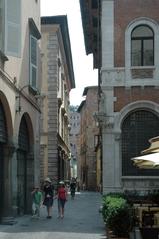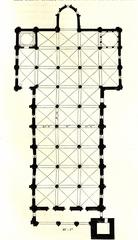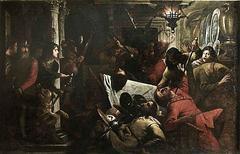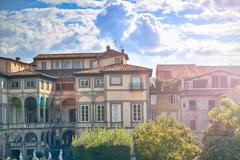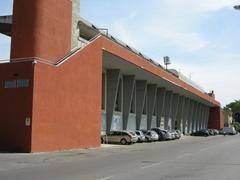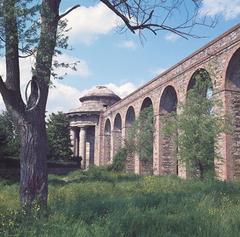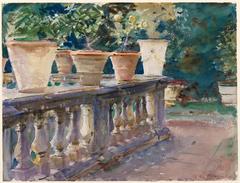Baluardo San Salvatore: Visiting Hours, Tickets, and Historical Significance in Lucca, Italy
Date: 14/06/2025
Introduction
Baluardo San Salvatore is a cornerstone of Lucca’s Renaissance-era city walls, offering visitors a unique opportunity to walk through centuries of military innovation and cultural evolution. As one of the best-preserved bastions in Tuscany, it blends the city’s defensive past with vibrant present-day activities—making it an essential stop for anyone interested in history, architecture, or Italian heritage. This guide provides a detailed overview of the bastion’s history, architecture, visitor information, and practical tips to help you make the most of your visit (Wikipedia).
Table of Contents
- Historical Origins and Evolution
- Renaissance Transformation and Bastion Construction
- Defensive Role and Architectural Features
- Cultural Significance: Via Francigena and Events
- Visiting Baluardo San Salvatore: Hours, Tickets, and Accessibility
- Visitor Experience and Amenities
- Practical Tips for Your Visit
- Frequently Asked Questions (FAQ)
- Conclusion
- References
Historical Origins and Evolution
The defensive legacy of Lucca began in the Roman era and was continually reinforced through the Middle Ages. Early fortifications, established around 180 BC, marked the city’s urban footprint and provided basic protection. During the medieval period, Lucca’s walls were expanded and fortified with stone, semi-circular towers, and fortified gates, responding to the city’s growing political and economic significance (Lieux Insolites). By the 13th century, these defenses included drawbridges and barbicans, but the advent of gunpowder would soon render them obsolete.
Renaissance Transformation and Bastion Construction
The introduction of artillery in the late 15th and early 16th centuries fundamentally changed siege warfare. After the Italian Wars and the campaigns of Charles VIII, Lucca’s medieval defenses proved inadequate. In 1543, the city’s leadership initiated a sweeping modernization, replacing medieval walls and towers with the latest in Renaissance military architecture: massive, angled bastions designed to absorb and deflect cannon fire (Wikipedia).
Construction of the new walls and bastions—including Baluardo San Salvatore—began in 1544. Key engineers such as Jacopo Seghezzi, Galeazzo Alghisi, Baldassarre Lanci, and Francesco Paciotto contributed to the design, drawing on the “trace italienne” star fort system. The project continued for over a century, culminating in a formidable defensive circuit completed by 1650 (Two Parts Italy).
Defensive Role and Architectural Features
Baluardo San Salvatore is a textbook example of Renaissance military engineering:
- Angular, pentagonal shape: Allows defenders to cover adjacent walls with overlapping fields of fire.
- Thick, sloped walls: Up to 12 meters thick at the base, faced in brick and stone to absorb artillery.
- Vaulted casemates: Underground chambers for troops, munitions, and artillery, with passageways (sortite) for sorties and counterattacks.
- Ramparts and parapets: Once lined with cannons and now serving as pedestrian promenades with sweeping city views.
- Moats and ravelins: Defensive features, some of which are still visible today.
These innovations enabled Lucca to resist powerful neighbors and maintain its independence well into the modern era (Lieux Insolites).
Cultural Significance: Via Francigena and Events
The Via Francigena
Beyond military purposes, Baluardo San Salvatore is closely linked to the Via Francigena, the ancient pilgrimage route from Canterbury to Rome. Lucca has long been a major pilgrimage stop, famed for relics such as the Volto Santo in the Cathedral of San Martino. Today, the bastion hosts the Via Francigena Entry Point—a multimedia museum and hospitality center for pilgrims and cultural travelers (Visit Tuscany).
Contemporary Cultural Activities
Baluardo San Salvatore is a vibrant cultural hub:
- Lucca Historiae Fest: The bastion is a central venue for this annual festival featuring Renaissance reenactments, historical workshops, and performances by local groups (Turismo Lucca).
- Art exhibitions and book fairs: Regularly hosted in the adjacent casermetta and Casa del Boia.
- Educational programs: Guided tours, lectures, and workshops engage schools and universities, fostering civic pride and historical awareness.
The site’s integration with urban life—serving as a green space and event venue—reflects Lucca’s commitment to living heritage (turismo.lucca.it).
Visiting Baluardo San Salvatore: Hours, Tickets, and Accessibility
Location: Northern section of the Lucca city walls, easily reached from the city center.
Opening Hours:
- Bastion and ramparts: Open daily, 8:00 AM to sunset (year-round).
- Via Francigena Entry Point museum: Tuesday–Sunday, 10:00 AM–6:00 PM; closed Mondays. Hours may vary during holidays or special events (turismo.lucca.it).
Tickets:
- Access to the bastion and walls: Free.
- Via Francigena Entry Point: €5 for adults (reduced rates for children and seniors). Tickets available on-site or online.
Accessibility:
- Wide, gently sloping ramps and well-maintained paths accommodate wheelchairs, strollers, and bicycles.
- Ramps and elevators are available in some areas; certain underground sections may be less accessible.
Facilities:
- Rest areas, shaded lawns, and benches.
- Interpretive signage and interactive digital exhibits.
- Caffetteria del Baluardo San Salvatore for refreshments.
- Public restrooms nearby.
Getting There:
- Walking: 15 minutes from Lucca Train Station; main access via Porta Santa Maria or Porta Elisa.
- Parking: Designated lots outside the walls; city center is best explored on foot or by bike.
Visitor Experience and Amenities
- Walking and Cycling: The 4.2-kilometer city wall circuit is ideal for walking, jogging, or cycling. Bike rentals are available throughout Lucca.
- Photography: Baluardo San Salvatore offers panoramic views of Lucca’s medieval towers, rooftops, and the Tuscan countryside. The golden hour is especially recommended for photography.
- Green Spaces: Expansive lawns and mature trees create a serene atmosphere, perfect for picnics or relaxation.
- Cultural Engagement: Interactive exhibits at the Francigena Entry Point, seasonal events, and workshops provide immersive experiences.
- Nearby Attractions: Easily combine your visit with Lucca Cathedral, Piazza dell’Anfiteatro, Torre Guinigi, Palazzo Pfanner, and San Frediano Church—all within walking distance (turismo.lucca.it).
Practical Tips for Your Visit
- Best Time to Visit: Late spring to early autumn (April–October) provides the best weather. Early mornings and late afternoons are quieter and offer better lighting for photos (weather2travel.com).
- What to Bring: Comfortable walking shoes, sun protection, water, and a camera.
- Accessibility: Most areas are wheelchair-friendly, but check ahead if you wish to explore underground chambers.
- Events: For festivals like the Lucca Historiae Fest, arrive early to secure a good viewing spot. Check the Lucca tourism calendar for event dates.
- Respect the Site: Follow all guidelines, especially regarding photography, litter, and pet policies.
Frequently Asked Questions (FAQ)
Q: Is there an entrance fee?
A: Access to the bastion and city walls is free. The Via Francigena Entry Point museum charges €5 for adults, with discounts available.
Q: Are pets allowed?
A: Yes, pets are typically allowed on the walls and bastion if kept on a leash.
Q: Is the site wheelchair accessible?
A: The ramparts and main pathways are accessible; some underground areas may have limited access.
Q: Can I rent a bike?
A: Bike rentals are available throughout Lucca, and cycling the walls is a popular activity.
Q: Are guided tours available?
A: Yes, guided tours and workshops are offered, especially during peak seasons and festivals. Advance booking is recommended.
Q: What are the nearby attractions?
A: Lucca Cathedral, Piazza dell’Anfiteatro, Torre Guinigi, San Frediano Church, Palazzo Pfanner, and Via Fillungo shopping street are all within easy reach.
Conclusion
Baluardo San Salvatore epitomizes Lucca’s historical resilience and its vibrant community spirit. From its origins as a Renaissance stronghold to its modern role as a center for culture, education, and recreation, the bastion is a living testament to the city’s enduring legacy. Whether you’re admiring its architecture, exploring the Via Francigena Entry Point, or attending a festival, this site offers a rich and rewarding experience for every visitor.
Plan your trip by consulting current visiting hours and event listings on the official Lucca Tourism website, and consider downloading the Audiala app for guided tours and exclusive content. Discover the layers of history and culture at Baluardo San Salvatore—your gateway to the spirit of Lucca.
References and Further Information
- Visit Tuscany: Via Francigena Entry Point in Lucca
- Lieux Insolites: Lucca Fortifications
- Wikipedia: Walls of Lucca
- Two Parts Italy: Underneath the Walls of Lucca
- Turismo Lucca: Lucca Historiae Fest
- Turismo Lucca: Visiting Baluardo San Salvatore
- Weather2Travel: Lucca Climate
- Lucca What’s On: Historiae Fest
- Comune di Lucca: Via Francigena Entry Point
- Sistema Museo
- Visit Italy: Lucca Travel Tips
